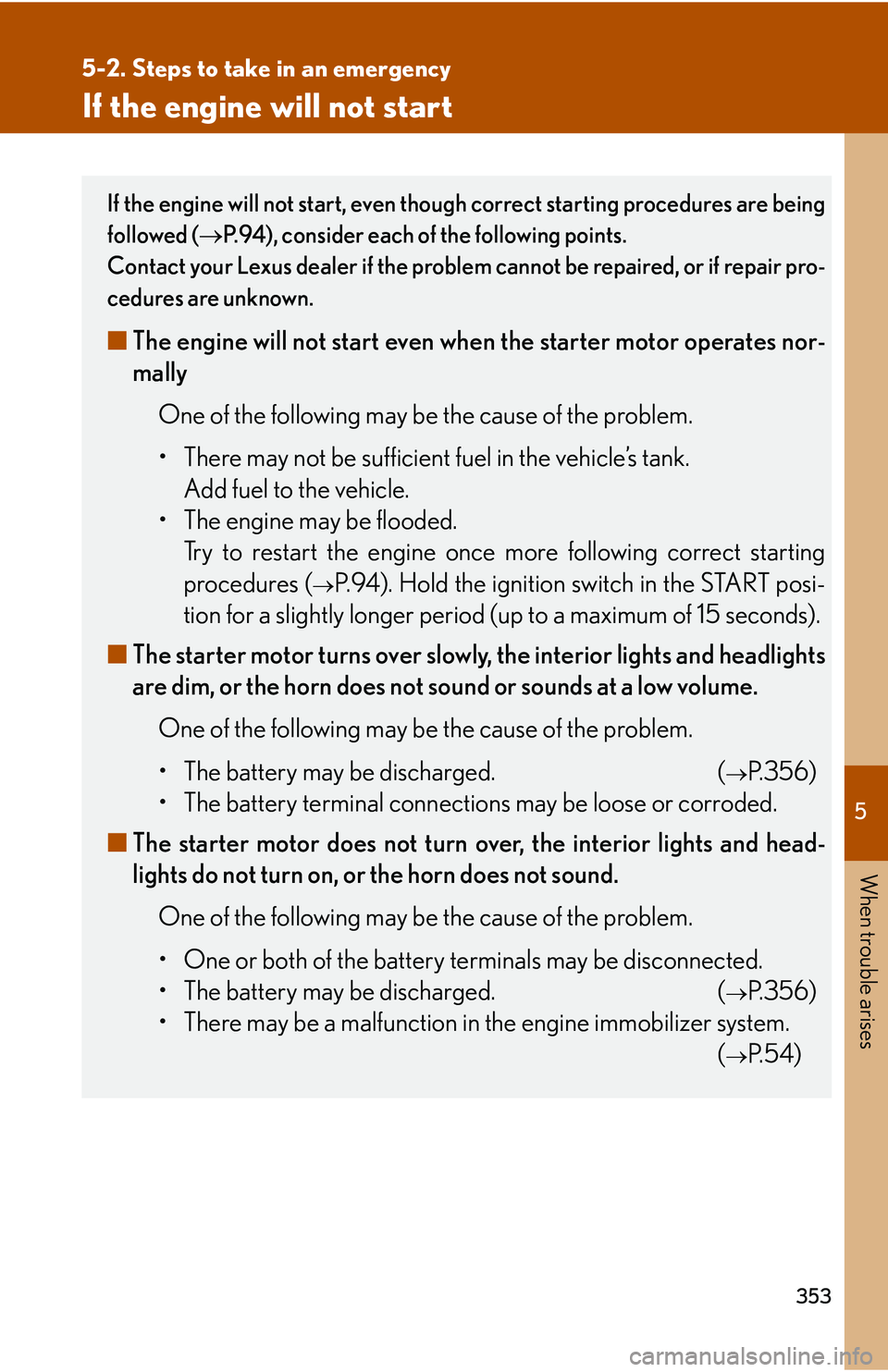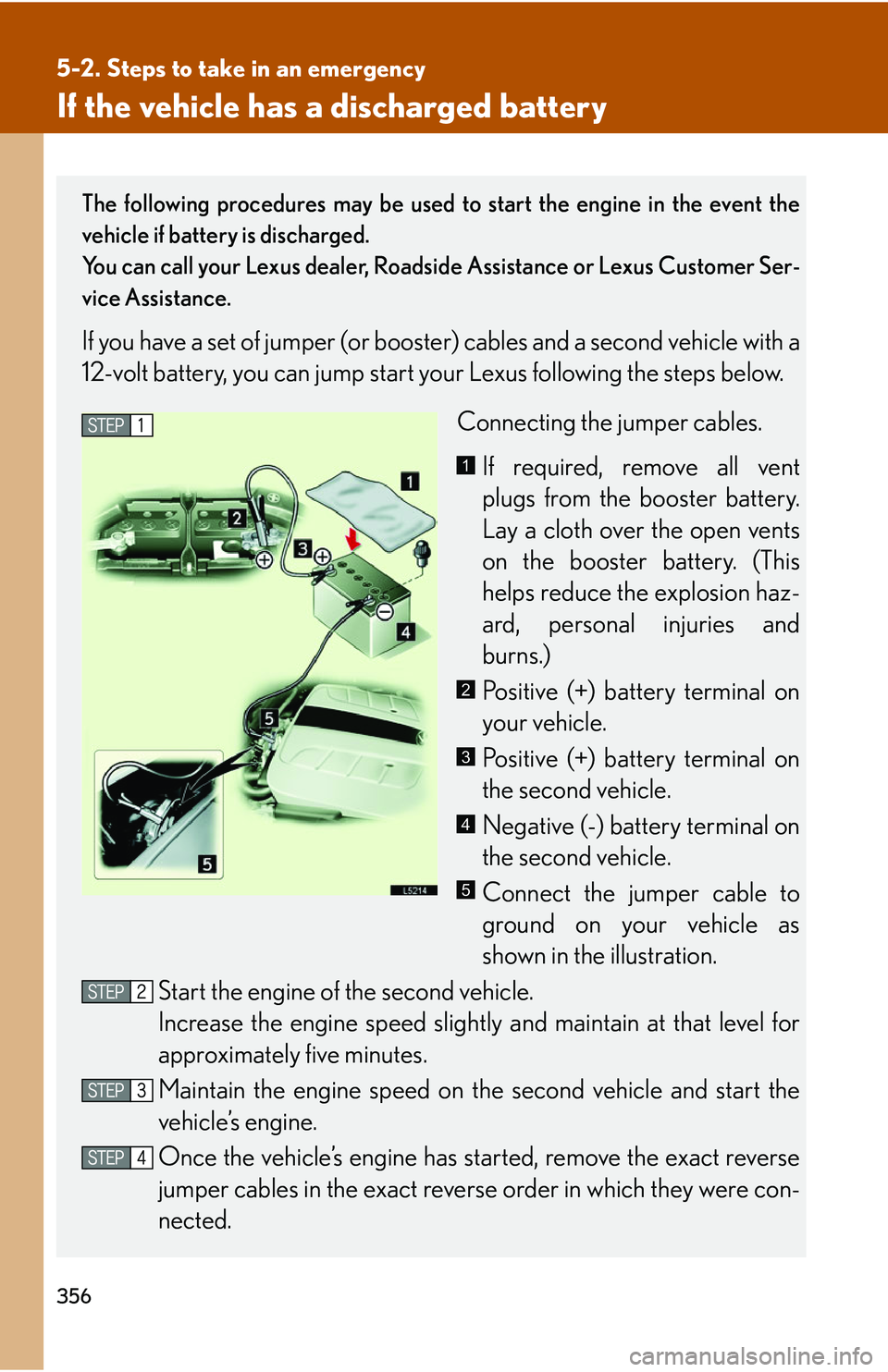Page 364 of 419
348
5-2. Steps to take in an emergency
Replacing a flat tire
Chock the tires.
Slightly loosen the wheel nuts (one
turn).
Wheel
chocks
Flat tireWheel chock positions
Front tire
Left-
hand
sideBehind the rear
right-hand side
tire
Right-
hand
sideBehind the rear
left-hand side tire
Rear tire
Left-
hand
sideIn front of the
front right-hand
side tire
Right-
hand
sideIn front of the
front left-hand
side tire
Wheel nut
wrench
Page 365 of 419
5
When trouble arises
349
5-2. Steps to take in an emergency
Turn the tire jack joint “A” by hand
until the jack is in contact with the
jack point.
Raise the vehicle until the tire is
slightly r
aised off the ground.
Remove all the wheel nuts and the
tir
e.
When resting the tire on the
gr
ound, place the tire so that the
wheel design faces up to avoid
scratching the wheel surface.
A
Tire Jack
Ti r e J a c k
position
Jack point
Ti r e J a c k
handle
Page 369 of 419

5
When trouble arises
353
5-2. Steps to take in an emergency
If the engine will not start
If the engine will not start, even though correct starting procedures are being
followed (P.94), consider each of the following points.
Contact your Lexus dealer if the problem cannot be repaired, or if repair pro -
cedures are unknown.
■ The engine will not start even wh en the starter motor operates nor-
mally
One of the following may be the cause of the problem.
• There may not be sufficient fuel in the vehicle’s tank.
Add fuel to the vehicle.
• The engine may be flooded.
Try to restart the engine once mor
e following correct starting
procedures (
P. 94 ). Hold the ignition switch in the START posi -
tion for a slightly longer period (u p to a maximum of 15 seconds).
■ The star
ter motor turns over slowly , the interior lights and headlights
are dim, or the horn does not sound or sounds at a low volume.
One of the following may be the cause of the problem.
• The battery may be discharged. (
P.356 )
• The battery terminal connectio ns may be loose or corr
oded.
■ The star
ter motor does not turn over, the interior lights and head-
lights do not turn on, or the horn does not sound.
One of the following may be the cause of the problem.
• One or both of the battery terminals may be disconnected.
• The battery may be discharged. (
P.356 )
• There may be a malfunction in the engine immobilizer system. (
P.54)
Page 372 of 419

356
5-2. Steps to take in an emergency
If the vehicle has a discharged battery
The following procedures may be used to start the engine in the event the
vehicle if battery is discharged.
You can call your Lexus dealer, Roadside Assistance or Lexus Customer Ser -
vice Assistance.
If you have a set of jumper (or boos ter) cables and a second vehicle with a
12-volt battery, you can jump start y our Lexus following the steps below.
Connecting the jumper cables.If required, remove all vent
plugs from the booster battery.
Lay a cloth o
ver the open vents
on the booster battery. (This
helps reduce the explosion haz -
ard, personal injuries and
bur
ns.)
Positive (+) battery terminal on
your vehicle.
Positive (+) battery terminal on
the second vehicle.
Negative (-) battery terminal on
the second vehicle.
Connect the jumper cable to
ground on your vehicle as
sho
wn in the illustration.
Start the engine of the second vehicle.
Increase the engine speed slightly and maintain at that le
vel for
approximately five minutes.
Maintain the engine speed on the second vehicle and start the
vehicle’s engine.
Once the vehicle’s engine has st ar
ted, remove the exact reverse
jumper cables in the exact reverse or
der in which they were con-
nected.
1
2
3
4
5
Page 373 of 419

5
When trouble arises
357
5-2. Steps to take in an emergency
■Avoiding a discharged battery
●Turn off the headlights and the audio system while the engine is turned off.
●Turn off any unnecessary electrical comp onents when the vehicle runs at a low
speed for an extended period, such as in heavy traffic, etc.
CAUTION
■Avoiding battery fires or explosions
Observe the following precautions to prevent accidentally igniting the flammable
ga
s that may be emitted from the battery.
• Make sure the jumper cable is connected to
the correct terminal and that it is
not unintentionally in contact with any part other than the intended terminal.
• Do not allow the booster cables to come into cont
act with the + and - terminals.
• Do not generate a flame near the battery b
y using a match, cigarette lighter, or
smoking.
■Battery precautions
The battery contains poisonous and corrosive electrolyte, while related parts con -
tain lead and lead compounds.
Observe the following precautions when handling the battery.
• Do not lean over the battery
• When working with the battery, always we ar safety glas
ses and take care not to
allow any battery fluids (acid) to come into contact with skin, clothing or the
vehicle body.
• In the event that battery fluid comes into co
ntact with the skin or eyes, immedi-
ately wash the affected area with water and seek medical attention. Place a wet
sp
onge or cloth over the affected area until medical attention can be received.
• Always wash your hands after ha
ndling battery-related parts.
• Do not allow children near the battery.
Once the engine starts, have the vehicle checked at your Lexus dealer as
soon as possible.
Page 384 of 419
368
6-1. Specifications
Electrical system
Differential
Battery
- Open voltage at
68F (20 C):
12.7 V Fully charged
12.3 V Half charged
11.9 V Discharged
[Voltage checked 20 minutes after the key is
removed with all the lights turned off]
- Charging rates5 A max.
Oil capacity1.42 qt. (1.35 L, 1.19 lmp.qt.)
Oil type and
viscosity
Vehicles without syn -
thetic oil information
label
Hypoid gear oil API GL-5
Above 0 F(-
18 C): SAE 90
Below 0 F(-
18 C): SAE 80W or
SAE 80W-90
Vehicles with
synthetic oil
information label*
Toyota Genuine Differential
Synthetic gear oil
API GL-5 SAE 75W-90
or its equivalent
Page 388 of 419
372
6-1. Specifications
Light bulbs
A: HB3 halogen bulbs
B: D2S discharge bulbs
C: HB4 halogen bulbs
D: Wedge base bulbs
E: Double end bulbs
F: Single end bulbs
Light BulbsBulb No.WTy p e
Exterior
Headlight (Low beam)35B
Front turn signal light21D
Headlight (High beam)900560A
Parking light5D
Fog lights900651C
Front side marker light5D
Trunk light1943.8D
High mounted stoplight21D
Rear turn signal light21D
Back-up light92116D
License plate light5D
Interior
Front personal lights8F
Front vanity lights3E
Rear vanity lights3E
Interior lights8E
Rear personal lights8F
Door courtesy lights1943.8D
Page 389 of 419

373
6-1. Specifications
6
Vehicle specifications
Fuel information
■Fuel tank opening for unleaded gasoline
●To help prevent incorrect fueling, your Lexus has a fuel tank opening that will
only accept the special nozzle on unleaded fuel pumps.
●If premium fuel is not available, you may temporarily use unleaded gasoline with
an Octane Rating as low as 87 (Research Octane Number 91).
■If your engine knocks ...
●Consult your Lexus dealer.
●You may occasionally notice light knocking for a short time while accelerating
or driving up hills. This is normal and there is no need for concern.
■Gasoline quality
In very few cases, driveability problems may be caused by the brand of gasoline you
ar
e using. If driveability problems persist, try changing the brand of gasoline. If this
does not correct the problem, consult your Lexus dealer.
■Gasoline quality standards
●Automotive manufacturers in the US, Europe and Japan have developed a
specification for fuel quality called World-Wide Fuel Charter (WWFC) that is
expected to be applied worldwide.
●The WWFC consists of four categories that are based on required emission
levels. In the US, category 3 has been adopted.
●The WWFC improves air quality by lowering emissions in vehicle fleets, and
customer satisfaction through better vehicle performance.
Your vehicle must use on ly unleaded gasoline.
Select premium unleaded gasoline with an
Octane Rating of 91 (Research
Octane Number 96) or higher for optimum engine performance.
At minimum, the gasoline you use sh ould meet the specifications of
ASTM D4814 in the USA and CGSB 3.5-M93 in Canada.